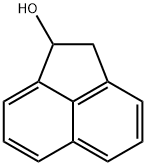1-Acenaphthenol is a white to cream solid in appearance. It is almost insoluble in water.
1-Acenaphthenol is a stable and combustible chemical substance. It is incompatible with
strong oxidising agents. It is used in the syntheses of organic compounds.
Exposures to 1-acenaphthenol cause irritant effects. It is harmful by ingestion, inhalation,
as well as through skin absorption. There are no complete data on the toxicology of
1-acenaphthenol.
1-Acenaphthenol is a white to cream solid in appearance. It is almost insoluble in water.
1-Acenaphthenol is a stable and combustible chemical substance. It is incompatible with
strong oxidizing agents. It is used in the syntheses of organic compounds.
1-Acenaphthenol is a product of the microbial metabolism and photolysis of acenaphthene, of acenaphthene, a polycyclic hydrocarbon that has potential to act as polyploidizing agents in plants. 1-Acenaphthenol is also a known substrate of dihydrodiol dehydrogenases.
Exposures to 1-acenaphthenol cause irritant effects. It is harmful by ingestion, inhalation,
or skin absorption. There are no complete data on the toxicology of 1-acenaphthenol.
If highly coloured (yellow), dissolve it in boiling *benzene (14g in 200mL), add charcoal (0.5g), filter it through a heated funnel, concentrate to 100mL and cool to give almost colourless needles. *Benzene vapour is TOXIC; use an efficient fume cupboard. The acetate has b 166-168o/5mm (bath temperature 180-185o). [Cason Org Synth Coll Vol III 3 1955.] It can also be recrystallised from *C6H6 or EtOH [Fieser & Cason J Am Chem Soc 62 432 1940]. It forms a brick-red crystalline complex with 2,4,5,7-tetranitrofluoren-9-one which is recrystallised from AcOH and is dried in a vacuum over KOH and P2O5 at room temperature, m 170-172o [Newman & Lutz J Am Chem Soc 78 2469 1956]. [Beilstein 6 IV 4623.]

